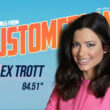Four ex-therapists discuss their shift to UX — and what’s still applicable from their old professional lives.
Bree Fouss’ first job out of graduate school, for occupational therapy, was at an outpatient pediatric clinic in Washington, D.C. Occupational therapists help patients who have injuries or disabilities improve skills needed for daily life. Her work at the clinic — helping children who had sensory processing disorders — was important, but also physically and emotionally taxing.
After about a year and a half, she took a new job — still rooted in occupational therapy, but less focused on direct patient care, more on organizational management. But the hours remained long, and she still couldn’t shake the feeling of exhaustion. Even though she had spent years in training for occupational therapy, Fouss decided to make a career change.
By Stephen Gossett
Occupational therapy is physiological work, with a heavy focus on motor-skill improvement, but there’s also a psychological and cognitive component. UX felt like a logical way to apply that latter aspect of her training in a field with more career advancement and less burnout. She enrolled at a UX bootcamp, and it didn’t take long for parallels between her old and new lines of work to emerge.
Clinical and Behavioral Therapy Principles That Apply to UX
- Reflective listening and the OARS communication model
- Unconscious and subconscious influence
- Clinical roleplay
- SMART goal-setting
- Thesis-based academic research
“When you’re doing user interviews, for instance, you have to build rapport, be personable, understanding and empathetic.” said Fouss, who now works as a design strategy lead at health insurance company Humana. “That’s exactly what a therapist does.”
As others who’ve also made the jump from occupational therapy to UX have pointed out, both focus on research-driven problem definition, intervention planning and implementation review. The same could be said for other lines of therapy, too.
Of course, therapy and UX are unique disciplines with unique challenges and not everything that pertains to one field automatically translates to the other. But what aspects of therapy are applicable to UX? We spoke with UX professionals who’ve made the switch.
From Behavioral Therapy to UX
Zosia Czerska studied neuroscience and behavior and worked for several years as a behavioral therapist in Washington, D.C., often with autistic patients, before shifting to UX. She received a UX/UI certificate from the bootcamp Bloc (now owned by Thinkful) and is now pursuing a design thinking certificate through the University of Virginia’s Darden School of Business.
Czerska said her background has helped her frame design thinking as a scientific process, and her understanding of how environmental factors influence responses has improved her ability to analyze user journeys.
“When you look at where a persona starts their journey, it’s easier to identify more details and pain points,” she said.
Still, many of the therapeutic frameworks and resources she studied in her previous professional life are a bit too specialized to translate directly to UX. But one concept is very applicable, particularly in user research, according to Czerska: reflective listening.
The technique involves communicating back what a speaker has said, so the listener can better understand the speaker’s thoughts, and to make sure that they’ve understood it correctly. It can be as simple as repeating back the speaker’s words, or the listener could reflect back certain behaviors they noticed in the speaker, too. It communicates empathy, but also neutrality.
“That way you can delve deeper without agreeing or disagreeing,” Czerska said.
It is also one of the components that makes up the communication model called OARS: open-ended questions, affirming statements, reflective listening and summarizing. Although Czerska finds reflective listening the most useful of the four techniques, the full model may also be worth exploring for UX researchers.
From Clinical Psychological Therapy to UX
Before moving into UX, Carolina Bianco worked for six years as a clinical therapist in her native Argentina. At the same time, she applied her psychology expertise at a tech bootcamp in Buenos Aires as a support counselor for students. That’s also where she first learned of UX.
The field seemed to offer a way to marry her previous professional experience with a burgeoning interest in technology. It also seemed to offer more stability. Bianco never experienced the kind of burnout that Foss described, but the work, and the precariousness of working as an independent contractor, were stressful enough to prompt a shift. Today, she works as a senior UX researcher for digital payment platform WorldRemit, in London.
Bianco said her therapy background has helped her foreground the importance of context — just as a patient’s issues are complicated by their environment, user problems exist in the context of full design systems. It’s also helped her check her own biases. Many of WorldRemit’s customers are immigrants who use the platform to send money to people in their native countries. Bianco is an immigrant herself, but is careful not to universalize her own experience onto users, just as a therapist shouldn’t project their personal perspective onto patients.
There’s also patient (or user) advocacy. UX research hinges on gleaning information from participants, but the process can’t be purely extractive.
“We need to have a care-centric approach and think about, what will we give these people back? Hopefully something that will make their lives easier,” she said.
But, according to Bianco, the most impactful concept that a UX professional can channel from the world of psychological therapy is the old notion of unconscious or subconscious influence. Don’t put your users on the metaphorical couch, but do understand what’s not being said, or what a user can’t quite articulate, might be of some note.
“It’s so important to actually listen and read between the lines,” she said.
Users might struggle to express exactly why they choose the actions they do, so researchers have to thoughtfully tease out those motivations. One method for doing so that some in UX recommend is the five whys — repeatedly asking why something is the case (tactfully, not badgeringly) to determine a root cause.
From Occupational Therapy to UX
Fouss’ journey away from occupational therapy appears to be representative in a couple of ways.
For one, the burnout she described unfortunately seems to be an evergreen cause of concern in the field. About one in two occupational therapists experiences burnout, according to recent research. The fact that there are at least two Facebook groups, both with tens of thousands of members, intended to support occupational therapists who have transitioned — or hope to transition — away from clinical practice also seems notable in this context.
Second, UX seems to be a popular off-ramp. The Non-Clinical PT, a resource for occupational and physical therapists considering new career paths, has shared examples of occupational therapists becoming designers. (The similarity between patient evaluation and user problem definition again emerges in some of their reflections.) And the site also includes a UX-focused lecture in its resource modules for alternative career exploration.
Given such crossover, what might UX professionals mine from the world of occupational therapy? Generally speaking, prioritization of accessibility. Jonas Raider, an occupational therapist-turned-UX researcher, has written about how occupational therapy instills its practitioners with a great awareness of accessibility design. Fouss agreed with that assessment and noted that inclusive design similarly recognizes the fact that disabilities are sometimes situational. As the classic example goes, a design that accommodates someone with one hand does so for someone with a broken hand, too.
But in terms of specific tactics, Fouss recommends a technique she picked up in graduate school while studying occupational therapy. The professor would have students roleplay therapist-patient interactions, record the “sessions” and play them back for review.
“You would learn a lot about yourself — your body language, your tone of voice — that you never would have known,” she said.
UX researchers might want to try the same exercise, but roleplaying researcher-user sessions with colleagues, to pick up on any potential habits that might inhibit building rapport. “It’s a really good way to reflect on how you connect with people,” Fouss said.
Occupational therapists also often use what’s called the SMART criteria for setting goals with patients. That means goals should be specific, measurable, attainable, relevant and time-based. Fouss said she hasn’t used the framework in direct UX work but does find it useful for her own professional goal-targeting.
From Speech Language Therapy to UX
Speech language pathology — a field that includes the treatment of speech impairments and swallowing disorders — has a fair amount in common with occupational therapy. Both roles are considered related services, speech language pathologists and occupational therapists often work together helping patients. And the basic frameworks of each process — patient evaluation and treatment planning and appraisal — mirror one another. So perhaps it’s no surprise that some speech language pathologists have also moved to UX.
Swati Nikumb is a UX researcher at User Research International. Previously, she worked as a speech language pathologist, first with school-aged children with mild speech impairments, then in a skilled nursing facility, treating adult patients with strokes, Parkinson’s disease and other conditions. The work was rewarding, but the strain and bureaucracy of the job outweighed the sense of satisfaction. After about two years of clinical therapeutic work, she decided to pursue UX.
Looking back, Nikumb could still see clear parallels between her old clinical work and current user research, from zeroing in on underlying issues to developing an empathetic bedside manner. (Bethany Riebock, a former speech language pathologist who now works as a UX researcher at Capital One, has pinpointed similar analogues.)
But despite all those connections, Nikumb said her thesis-based research, rather than clinical study and practice, translates even more. Graduates of postgraduate programs that require empirical research “will have these really fundamental skills that can be so helpful when it comes to user research,” Nikumb said.
“Because you’re doing the same thing — thinking about a large problem, how to break it down and what kind of protocols to put to it.”
That said, Nikumb isn’t recommending anyone tackle an advanced degree in their spare time simply in hope of some trickle-down benefits. But her path serves as a reminder that even circuitous paths to UX can have their upsides and that those transitioning to design from academic backgrounds may find success by zeroing in on user research.
It’s also a testament to the educational value of applied research, regardless of application. As the research community continues to find value in citizen science, that’s worth remembering for any UX professionals considering volunteer options.
This article originally appeared in BuiltIn.













